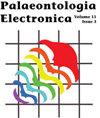The inner morphology of the petrosal bone of the endemic elephant of Tilos Island, Greece
IF 1.5
4区 地球科学
Q1 Earth and Planetary Sciences
引用次数: 2
Abstract
The bony labyrinth, as part of the inner structure of the petrosal bone, contains the sensory organs of balance and hearing. The semicircular canals, as part of the vestibular apparatus of the inner ear, are involved in the detection of angular motion of the head for maintaining balance and guiding locomotor behavior. While the overall structure of the bony labyrinth is inaccessible embedded in the petrosal bone, high resolution computed tomography makes the study of these structures possible. The purpose of this study is to visualize and precisely quantify the complex inner ear structures of the insular mammal Palaeoloxodon tiliensis and comment on the relationship of these morphologies to the agility and hearing frequency ranges. This study focuses on imaging the shape of the bony labyrinth as well as the semicircular canals, of three petrosal bones, using micro-computed tomography (micro-CT). Shape and size analysis of the cochlea allow for an assessment of morphological differences between species. Specifically, measuring the dimensions of inner ear components as well as the angular distances can express the variation in their balancing abilities and the frequencies of their auditory perception. The morphological characteristics obtained through micro-CT lead to the conclusion that P. tiliensis retained similar conditions to that of its larger relatives, and it was an animal that had hearing in the low frequency ranges. Dionysia E. Liakopoulou. National and Kapodistrian University of Athens, Faculty of Geology and Geoenvironment, Panepistimiopolis, 15784 Athens, Greece, dliakopoulou@geol.uoa.gr George E. Theodorou. National and Kapodistrian University of Athens, Faculty of Geology and Geoenvironment, Panepistimiopolis, 15784 Athens, Greece, gtheodor@geol.uoa.gr Anneke H. van Heteren. Zoologische Staatssammlung München – Staatliche Naturwissenschaftliche Sammlungen Bayerns, Münchhausenstraße 21, 81247 München, Germany; Ludwig-MaximiliansUniversität München, GeoBio-Center, Richard-Wagner-Straße 10, 80333 Munich, Germany; LudwigMaximilians-Universität München, Department Biologie II, Großhaderner Straße 2, 82152 PlaneggMartinsried, Germany, vanHeteren@snsb.de LIAKOPOULOU, THEODOROU, & VAN HETEREN: PETROSAL BONE MORPHOLOGY 2希腊提洛斯岛特有象岩骨的内部形态
骨迷路是岩骨内部结构的一部分,包含平衡和听觉的感觉器官。半规管作为内耳前庭器官的一部分,参与检测头部的角运动,以维持平衡和指导运动行为。虽然骨迷路的整体结构无法进入岩骨,但高分辨率计算机断层扫描使研究这些结构成为可能。本研究的目的是可视化和精确量化岛屿哺乳动物古力古齿的复杂内耳结构,并评论这些形态与敏捷性和听力频率范围的关系。本研究的重点是利用微型计算机断层扫描(micro-CT)对三个岩骨的骨迷路和半规管的形状进行成像。耳蜗的形状和大小分析允许对物种之间的形态差异进行评估。具体地说,测量内耳部件的尺寸和角距离可以表达它们的平衡能力和听觉感知频率的变化。通过显微ct获得的形态特征表明,猿人保留了与其较大亲缘动物相似的条件,是一种具有低频听力的动物。Dionysia E. Liakopoulou。雅典国立和卡波迪斯特里亚大学地质与地球环境学院,帕埃皮斯蒂米奥波利斯,15784雅典,希腊,dliakopoulou@geol.uoa.gr雅典国立和Kapodistrian大学地质与地球环境学院,Panepistimiopolis, 15784 Athens, Greece, gtheodor@geol.uoa.gr德国州动物科学州-德国州自然科学州,德国州豪斯特拉ße 21,81247;Ludwig-MaximiliansUniversität m nchen, GeoBio-Center, Richard-Wagner-Straße 10, 80333德国慕尼黑;LudwigMaximilians-Universität m nchen,生物II系,Großhaderner Straße 2, 82152 PlaneggMartinsried,德国,vanHeteren@snsb.de LIAKOPOULOU, THEODOROU, and VAN HETEREN:岩骨形态学2
本文章由计算机程序翻译,如有差异,请以英文原文为准。
求助全文
约1分钟内获得全文
求助全文
来源期刊

Palaeontologia Electronica
地学-古生物学
CiteScore
3.60
自引率
0.00%
发文量
20
审稿时长
>12 weeks
期刊介绍:
Founded in 1997, Palaeontologia Electronica (PE) is the longest running open-access, peer-reviewed electronic journal and covers all aspects of palaeontology. PE uses an external double-blind peer review system for all manuscripts. Copyright of scientific papers is held by one of the three sponsoring professional societies at the author''s choice. Reviews, commentaries, and other material is placed in the public domain. PE papers comply with regulations for taxonomic nomenclature established in the International Code of Zoological Nomenclature and the International Code of Nomenclature for Algae, Fungi, and Plants.
 求助内容:
求助内容: 应助结果提醒方式:
应助结果提醒方式:


